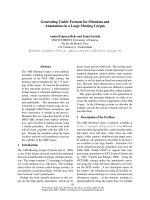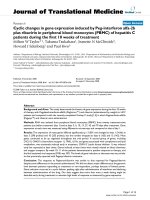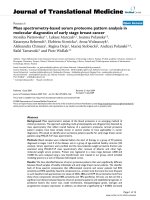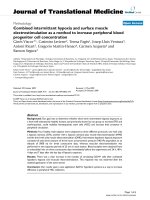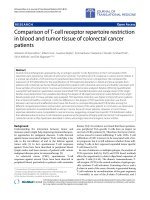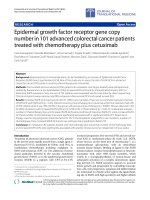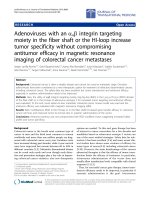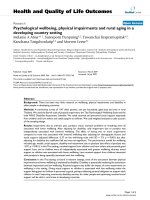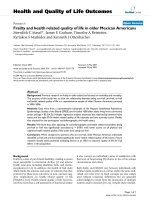báo cáo hóa học:"Cyclic cidofovir (cHPMPC) prevents congenital cytomegalovirus infection in a guinea pig model" pptx
Bạn đang xem bản rút gọn của tài liệu. Xem và tải ngay bản đầy đủ của tài liệu tại đây (385.36 KB, 7 trang )
BioMed Central
Page 1 of 7
(page number not for citation purposes)
Virology Journal
Open Access
Research
Cyclic cidofovir (cHPMPC) prevents congenital cytomegalovirus
infection in a guinea pig model
Mark R Schleiss*, Jodi L Anderson and Alistair McGregor
Address: Division of Infectious Diseases, University of Minnesota Department of Pediatrics, Center for Infectious Diseases and Microbiology
Translational Research, 2001 6th Street SE, McGuire Translational Research Facility, Minneapolis, Minnesota 55455, USA
Email: Mark R Schleiss* - ; Jodi L Anderson - ; Alistair McGregor -
* Corresponding author
Abstract
Background: Congenital cytomegalovirus (CMV) infection is a major public health problem.
Antiviral therapies administered during pregnancy might prevent vertical CMV transmission and
disease in newborns, but these agents have not been evaluated in clinical trials. The guinea pig
model of congenital CMV infection was therefore used to test the hypothesis that antiviral therapy,
using the agent agent cyclic cidofovir (cHPMPC), could prevent congenital CMV infection.
Results: Pregnant outbred Hartley guinea pigs were challenged in the early-third trimester with
guinea pig CMV (GPCMV) and treated with placebo, or the antiviral agent, cyclic cidofovir. To
optimize detection of vertical infection, an enhanced green fluorescent protein (eGFP)-tagged virus
was employed. Compared to placebo, cyclic cidofovir-treated dams and pups had reduced
mortality following GPCMV challenge. The magnitude of GPCMV-induced maternal and fetal
mortality in this study was reduced from 5/25 animals in the placebo group to 0/21 animals in the
treatment group (p = 0.05, Fisher's exact test). By viral culture assay, antiviral therapy was found
to completely prevent GPCMV transmission to the fetus. In control pups, 5/19 (26%) were culture-
positive for GPCMV, compared to 0/16 of pups in the cyclic cidofovir treatment group (p < 0.05,
Fisher's exact test).
Conclusion: Antiviral therapy with cyclic cidofovir improves pregnancy outcomes in guinea pigs,
and eliminates congenital CMV infection, following viral challenge in the third trimester. This study
also demonstrated that an eGFP-tagged recombinant virus, with the reporter gene inserted into a
dispensable region of the viral genome, retained virulence, including the potential for congenital
transmission, facilitating tissue culture-based detection of congenital infection. These observations
provide support for clinical trials of antivirals for reduction of congenital CMV infection.
Background
Congenital cytomegalovirus (CMV) infection is a major
public health problem. Transmission of CMV in utero
results in substantial long-term morbidity in newborns,
including mental retardation and sensorineural hearing
loss (SNHL; reviewed in [1]). Treatment of the affected
newborn with the anti-CMV nucleoside analogue, ganci-
clovir, improves the outcome of SNHL, but the response
is incomplete, and significant sequelae may persist even
following completion of antiviral therapy [2]. These
observations provide support for studying the approach
of administering antiviral agents administered prior to
Published: 01 March 2006
Virology Journal 2006, 3:9 doi:10.1186/1743-422X-3-9
Received: 30 December 2005
Accepted: 01 March 2006
This article is available from: />© 2006 Schleiss et al; licensee BioMed Central Ltd.
This is an Open Access article distributed under the terms of the Creative Commons Attribution License ( />),
which permits unrestricted use, distribution, and reproduction in any medium, provided the original work is properly cited.
Virology Journal 2006, 3:9 />Page 2 of 7
(page number not for citation purposes)
delivery, with the goal of preventing acquisition of infec-
tion in utero. Such therapy could potentially be employed
in pregnant women in the setting of documented fetal
CMV infection, as demonstrated by seroconversion to
CMV, or by amniotic fluid analysis confirming the pres-
ence of CMV genome. Although this intervention has
been attempted and described in a number of case reports
[3-5], it is not clear whether in utero therapy for CMV is
effective in interrupting vertical transmission, or reducing
disease.
Ideally, antiviral therapy strategies designed to prevent
congenital viral transmission would be evaluated in ani-
mal models prior to human clinical trials. One attractive
model is the guinea pig cytomegalovirus (GPCMV) model
[reviewed in [6]], since the GPCMV crosses the placenta,
causing infection and disease in utero. One significant lim-
itation of the GPCMV model is the resistance of GPCMV
to ganciclovir, the most clinically useful of the therapeutic
agents employed for management of human CMV infec-
tions [7,8]. GPCMV is susceptible, however, to cidofovir,
and its cyclic cogener, cHPMPC [8]. Treatment of guinea
pigs with cyclic cidofovir has been shown to be safe and
effective in ameliorating GPCMV disease, including laby-
rinthitis and associated SNHL [9,10]. However, to date
there is no published information about its efficacy in pre-
vention of congenital GPCMV infection in pregnant
guinea pigs. These studies were therefore undertaken to
evaluate the potential efficacy of cyclic cidofovir against
congenital GPCMV infection, using an enhanced green
fluorescent protein (eGFP)-tagged virus [11], to aid in the
detection of vertically transmitted infection in pups born
to animals challenged with GPCMV in the third trimester
of pregnancy.
Results
Characterization of vAM403: genome structure and virion
polypeptides
The details of construction of the eGFP-tagged recom-
binant GPCMV used in this study, vAM403, have been
previously described [11]. Briefly, this virus was generated
using gpt-mediated mutagenesis, with insertion of an
eGFP/gpt cassette in the Hind III locus of the GPCMV
genome, followed by clonal purification of recombinant
stock. Previous work indicated that this virus replicated
with wild-type kinetics in vitro, and was capable of wide-
spread dissemination and attendant mortality in cyclo-
phosphamide-immunocompromised guinea pigs in vivo
[12].
The structure of this recombinant virus is summarized in
Fig. 1a. Although this virus was known to produce disease
in vivo, virus-associated proteins encoded by this virus had
not been previously characterized. The insertion in the
Hind III locus was not anticipated to result in disruption
of any known proteins encoding by other betaherpesvi-
ruses, based on sequence analysis and comparison of this
sequence to the BLAST database [6]. To experimentally
characterize the protein profile of the vAM403 virus,
radio-immunoprecipitation assays were performed with
polyclonal anti-GPCMV antibodies, using polypeptides
purified from
35
S-labeled cells. Guinea pig lung (GPL)
cells were infected either with wild-type virus, or the
vAM403 recombinant. These studies indicated that the
polypeptide profile of the vAM403 virus, assessed by
immunoprecipitation assay, was essentially identical to
that of wild-type virus, with the exception of high-level
expression of the eGFP protein, which was confirmed
using an eGFP-specific monoclonal antibody (Fig. 1c). In
addition, in some experiments, vAM403-inoculated cells
had reduced levels of expression of a protein of ~85 kDa
(Fig. 1c, arrow). Expression of well-characterized GPCMV
proteins, including the glycoprotein B and UL83 (pp65)
homologs, was unchanged in the vAM403 mutant, com-
pared to wild-type virus (Fig. 1c). These studies, coupled
with previous vAM403 genome structure characterization
by gel electrophoresis and Southern blot [11] as well as
biological characterization in vivo [12], suggested that
insertion of the eGFP/gpt cassette had no major influence
on the biology of the virus, and no significant impact on
the expression of immunogenic, virus-associated
polypeptides.
Maternal and pup outcomes following vAM403 challenge
in pregnancy
The vAM403 virus had previously been shown to induce
disseminated GPCMV disease, and mortality, in cyclo-
phosphamide-immunosuppressed guinea pigs [12]. To
assess the virulence of this virus in pregnant guinea pigs,
outbred Hartley strain guinea pigs (n = 4) were challenged
with 1 × 10
7
pfu of vAM403 subcutaneously in the early
3
rd
trimester of pregnancy and pregnancy outcomes mon-
itored. In this initial study of GPCMV-challenged dams,
vertical transmission of virus was noted in 50% of pups,
as assessed by viral culture of pup tissue homogenates
(data not shown). In addition, placentas retrieved from
two pregnant dams revealed evidence of GPCMV by viral
co-culture and fluorescent microscopy (data not shown).
Thus, these observations reinforced the observations that
vAM403 could be virulent in immunosuppressed non-
pregnant animals, and provided a framework for antiviral
intervention studies with cyclic cidofovir.
Cyclic cidofovir reduces mortality and prevents GPCMV
transmission
To assess the ability of cyclic cidofovir therapy to interrupt
vertical GPCMV transmission, the eGFP-tagged vAM403
virus was used to challenge pregnant animals in the early
3
rd
trimester. A total of 9 dams were challenged with
vAM403 virus (dose, 1 × 10
6
pfu, administered subcutane-
Virology Journal 2006, 3:9 />Page 3 of 7
(page number not for citation purposes)
ously) and had evaluable pregnancy outcomes. A lower
dose of GPCMV was used in this study than in the pilot
study, in order to minimize the risk of maternal mortality
prior to delivery, so that the impact of antiviral therapy on
congenital infection could be clearly discerned. Cyclic
cidofovir (20 mg/kg) was administered to 4 animals, and
saline diluent (negative control) was administered to 5
animals. Antiviral drug was administered in a single dose,
via intraperitoneal route, 24 hours after subcutaneous
viral challenge with vAM403 virus. Animals were chal-
lenged in the early-third trimester, approximately 3 weeks
prior to anticipated delivery. Following viral challenge
and antiviral therapy administration, pregnancies were
monitored and pregnancy outcomes (pup and maternal
Characterization of recombinant, eGFP-expressing guinea pig cytomegalovirus (GPCMV) used for in vivo antiviral studiesFigure 1
Characterization of recombinant, eGFP-expressing guinea pig cytomegalovirus (GPCMV) used for in vivo anti-
viral studies. An eGFP-expressing, recombinant GPCMV was generated using gpt selection to enable detection of infection in
the guinea pig model of congenital CMV infection [11]. Panel A, genome map of GPCMV genome (Hind III digestion profile)
indicating site of insertion of eGFP/gpt cassette. Insertion of this cassette into GPCMV genome did not disrupt any predicted
conserved CMV open reading frames, based on homology comparisons with other CMVs and BLAST search [6]. Panel B, fluo-
rescence microscopy analysis of vAM403 virus in tissue culture. GPL cells were inoculated with recombinant virus and visual-
ized by FITC filter 96 hours post-infection. Panel C, analysis of vAM403 protein expression and comparison to wild-type
GPCMV. GPL cells infected with either wild-type virus (lanes 1, 3) or vAM403 (lanes 2, 4) were labelled with
35
S-methionine/
cysteine, and immunoprecipitated with either polyclonal anti-GPCMV antisera (lanes 1, 2) or a monoclonal antibody against
eGFP (lanes 3, 4). Position of molecular weight markers is indicated. Precipitation with serum from a GPCMV seronegative
guinea pig did not precipitate any viral proteins (data not shown). The pattern of proteins recognized by immune serum against
wild-type and vAM403 virus is virtually identical, with exception of a band of ~85 kDa present in wild-type infected cells, but
not present in vAM403-infected cells (arrow). Known positions of migration of gB complex (gp90 and gp58) are indicated, as is
the position of migration of UL83 homolog (arrowheads). The eGFP monoclonal antibody precipitated the ~30 kDa eGFP pro-
tein from vAM403 cells (lane 4, arrowhead), but not wild-type cells (lane 3).
Virology Journal 2006, 3:9 />Page 4 of 7
(page number not for citation purposes)
mortality) were assessed. In addition, congenital infection
rates were determined by co-cultivation of lung, liver and
spleen from pups, on GPL cells, and GPCMV was detected
by monitoring of cells by fluorescence microscopy, with
examination for eGFP-positive CMV plaques (Fig. 1B).
The results of these analyses are summarized in Tables 1
and 2. The overall magnitude of combined GPCMV-
induced maternal and fetal mortality in the placebo-
treated, GPCMV-infected group was 5/25 animals (20%;
includes 4 pups, and 1 dam which died shortly after deliv-
ery). In contrast, in animals treated with cyclic cidofovir,
the mortality was 0/21 dams and pups (0%; p = 0.05 vs.
placebo group, Fisher's exact test). Two of five litters in the
control group had pup mortality (40%), in contrast to no
pup mortality in any of four litters in the cyclic cidofovir-
treated animals. In control pups, 19 pups were available
for culture, and in cyclic cidofovir-treated animals, 16
pups were available for culture. Of these, 5 pups in the
control group (26%) were culture-positive for GPCMV,
compared to 0/16 pups (all liveborn) from the cyclic cido-
fovir-treated group (p < 0.05, Fisher's exact test). Among
maternal cultures, 2/5 (40%) of control dams were cul-
ture-positive from any visceral organ, compared to 0/4
(0%) of cyclic cidofovir-treated dams. Overall, cyclic cido-
fovir eliminated recovery of GPCMV by viral culture from
visceral organ in both dams and pups (7/24 of control
dams and/or pups were culture positive, versus 0/20 ani-
mals in cyclic cidofovir group; p = 0.01, Table 2). Thus,
antiviral therapy of the pregnant dam with cyclic cidofovir
completely eliminated congenital transmission of
GPCMV to the fetus, and also prevented visceral dissemi-
nation to maternal tissues, as assessed by viral culture
techniques.
Discussion
Interventions are urgently needed for the problem of con-
genital CMV infection. Although CMV vaccines are in var-
ious stages of preclinical development, none are currently
licensed for human use. Antiviral agents for CMV, in con-
trast, are available, and have already been shown to be
useful in the management of congenital and perinatal
CMV infections [2,13]. However, there is no conclusive
evidence that antiviral treatment of pregnant women is
capable of interrupting CMV transmission. Since the
guinea-pig model of CMV infection is the most authentic
non-primate animal model for study of interventions
against congenital CMV infection [14], these studies were
Table 1: Impact of Cyclic Cidofovir On GPCMV-Associated Mortality Following GPCMV (vAM403) Challenge During Third Trimester
of Pregnancy. Animals challenged in the early 3
rd
trimester of pregnancy were monitored for outcome by assessment of pup mortality
rates (liveborn versus dead pups) and GPCMV-associate maternal mortality. In 5 litters in the placebo (saline) group, there were 2
litters with dead pups (40%) and the overall mortality was 20%. One dam also died, shortly after childbirth, and had disseminated
GPCMV infection (liver, lungs, spleen). In contrast, cyclic cidofovir-treated animals had no pup or maternal mortality.
Control (Saline) Live Dead %
Maternal Mortality 4 1 20%
Pup Mortality 16 4 20%
Total Mortality 20 5 20%
Cyclic Cidofovir Live Dead %
Maternal Mortality 4 0 0
Pup Mortality 21 0 0
Total Mortality 25 0 0 *
* p = 0.05 vs. placebo, Fisher 's Exact Test
Table 2: Impact of Cyclic Cidofovir On Maternal and Congenital GPCMV Infection Rates. To assess the extent of maternal and
congenital GPCMV dissemination, both maternal and pup organs (liver, spleen, lung) were collected, both from animals who died
during course of experiment, and following euthanasia within 72 hours of delivery, and homogenates were co-cultured on GPL cells.
Congenital transmission was defined by any positive pup culture from any organ. The rate of congenital GPCMV transmission was 26%
in placebo-treated controls, versus 0% in cyclic-cidofovir treated dams. Among maternal cultures, 2/5 (40%) of control dams were
culture-positive, compared to 0/4 (0%) of cidofovir-treated dams. GPCMV was isolated from 3 dead pups, and 2 live pups, from 3
different litters in the control group, including both dams which were culture-positive from visceral organs, and, interestingly, one
control dam which was culture-negative from visceral organs.
Group Culture Positive Dams Culture Positive Pups Total Culture Positive Animals Congenital Transmission Rate
Placebo 2/5 5/19 7/27 26%
Cyclic Cidofovir 0/4 0/16 0/20
§
0%*
* p < 0.05 vs. placebo, Fisher 's Exact Test
§
p = 0.01 vs. placebo, Fisher 's Exact Test
Virology Journal 2006, 3:9 />Page 5 of 7
(page number not for citation purposes)
undertaken to test the hypothesis that an effective antivi-
ral agent might be capable of reducing transmission of
CMV during pregnancy.
The intrinsic resistance of GPCMV to the most commonly
used CMV antiviral, ganciclovir, precludes evaluation of
this agent for efficacy against congenital GPCMV infection
[7,8]. However, the cyclic cogener of cidofovir is highly
active against GPCMV in vitro and, therapeutic against dis-
seminated GPCVM disease, and against viral labyrinthitis
and SNHL, in vivo [8,9]. The molecular basis for the
improved activity of this agent against GPCMV, compared
to ganciclovir, is not clear, but it may derive from the fact
that cidofovir does not require phosphorylation by the
CMV U
L
97 kinase for antiviral activity, in contrast to gan-
ciclovir. Since the GPCMV U
L
97 homolog has significant
divergence (compared to HCMV) of amino acid sequence
in catalytic domains of the protein important for ganciclo-
vir phosphorylation, this may provide a molecular expla-
nation for the decreased susceptibility of GPCMV to this
nucleoside antiviral [15]. In any case, cyclic cidofovir has
been found to be not only highly effective against
GPCMV, but also non-toxic to animals [8]. The study
described in this report found that, following challenge
with an eGFP-tagged strain of GPCMV (vAM403), guinea
pigs that received cyclic cidofovir therapy (20 mg/kg, via
intraperitoneal route) had reduced overall maternal and
pup mortality, compared to placebo-treated controls. This
difference in overall mortality was statistically significant,
with a reduction from 5/25 (20%) in the placebo group,
to 0/21 (0%) animals in the cyclic cidofovir-treated group
(p = 0.05, Fisher's exact test). Furthermore, these studies
found that antiviral therapy resulted in elimination of
congenital GPCMV transmission. In untreated controls,
congenital GPCMV infection was demonstrated in 5/19
pups (26%), versus 0/16 pups in the cyclic cidofovir
group (p < 0.05, Fisher's exact test). These are the first data
to demonstrate that antiviral therapy during pregnancy
can prevent congenital CMV transmission. These observa-
tions provide support for more detailed examination of
cyclic cidofovir, and other antiviral agents, in this small
animal model of CMV transmission. These data may also
provide indirect support for potential clinical trials of
antiviral interventions in pregnant women at high risk of
transmission of CMV to the fetus, although caution
should be exercised in human studies, given the potential
for toxicity of these agents when used during pregnancy
[13]. A recent study of passive immunization of women at
high risk for giving birth to infants with symptomatic con-
genital CMV infection suggested that antibody therapy in
utero resulted in improved pregnancy outcomes [16].
Future controlled clinical trials will be required to further
assess the value as well as the potential toxicities of antivi-
ral interventions targeting CMV transmission in the preg-
nant patient.
An important observation from these studies was the
demonstration of the utility of using an eGFP-tagged,
recombinant CMV in the experimental modelling of con-
genital CMV infection. Previous studies using an eGFP-
tagged rhesus macaque CMV have demonstrated that the
resultant recombinant virus retained full pathogenicity in
the experimentally inoculated fetus in utero, but this
required direct inoculation of the fetus [17]. It was there-
fore of considerable interest to determine if the recom-
binant GPCMV used in these studies was capable of
resulting in transplacental infection and conferring mater-
nal and fetal disease in pregnant guinea pigs without
direct fetal inoculation. Characterization of the eGFP-
tagged GPCMV recombinant, vAM403, indicated that
insertion of the eGFP/gpt cassette into the GPCMV
genome, in the nonessential Hind III "N" locus, had min-
imal impact on viral protein expression compared to wild-
type virus, as assessed by SDS-PAGE. This observation,
coupled with the apparent absence of any conserved beta-
herpesvirus proteins encoded by this region of the
genome, as ascertained by DNA sequence analyses [6],
suggested that this virus would have the full potential for
virulence in animals. Consistent with this prediction, this
virus was found to be fully capable of transplacental trans-
mission, with attendant maternal and pup mortality, fol-
lowing subcutaneous inoculation of pregnant guinea pigs.
The future use of other eGFP-tagged viruses should facili-
tate study of congenital GPCMV infection in this model.
Targeted mutagenesis of the GPCMV genome cloned in E.
coli as an infectious bacterial artificial chromosome (BAC)
[18] will facilitate future, more detailed evaluation of the
role of viral genes in pathogenesis of maternal-fetal infec-
tion.
Conclusion
Targeted insertion of an eGFP/gpt cassette into the Hind III
'N' region of the GPCMV genome, using homologous
recombination techniques, resulted in generation of a
virus which retained full pathogenicity in pregnant guinea
pigs, including the potential for transplacental transmis-
sion. The recombinant virus, vAM403, retained a protein
synthesis profile similar to wild-type virus. The expression
of the eGFP reporter cassette in infected cells resulted in
the efficient and rapid detection of virus in experimentally
inoculated animals, including congenitally infected, new-
born pups. Recombinant virus was capable of infecting
the fetus, inducing disease and mortality, following exper-
imental inoculation of pregnant guinea pigs. Maternal
and fetal GPCMV disease and mortality was abrogated by
antiviral therapy with cyclic cidofovir. In addition, cyclic
cidofovir therapy eliminated congenital transmission of
GPCMV. These are the first data confirming that antiviral
treatment administered during pregnancy is capable of
modifying the course of CMV disease and preventing ver-
tical transmission of CMV in a relevant animal model of
Virology Journal 2006, 3:9 />Page 6 of 7
(page number not for citation purposes)
congenital infection, and provides support for future clin-
ical trials of antivirals in pregnant patients.
Methods
Analysis of eGFP/gpt recombinant virus
The construction of the vAM403 recombinant virus is
reviewed in detail elsewhere [11]. Recombinant, eGFP-
expressing virus was plaque-purified by limiting dilution,
and a workpool of viral stock was generated by cultivation
in guinea pig lung (GPL) cells (ATCC CCL158) and main-
tained in F-12 medium supplemented with 10% fetal calf
serum (Gibco-BRL). Viral stocks were prepared for in vivo
studies, and DNA was extracted from the cellular pellet by
sodium iodide ultracentrifugation and analyzed by agar-
ose gel electrophoresis and Southern blot analysis as pre-
viously described [11], to confirm the genome structure of
the eGFP/gpt cassette (data not shown). To examine
polypeptides synthesized by wild-type and vAM403
recombinant GPCMV, GPL monolayers were inoculated
at a multiplicity of infection of 10 plaque-forming units/
cell and subsequently were pulse-labelled for 4 hours with
35
S-methionine/cysteine (Express
®
protein labelling mix,
New England Nuclear), at a concentration of 50 μCi/ml
tissue culture medium, at 96 hours post-infection. Cellu-
lar lysates were prepared and subjected to SDS-PAGE, or
to RIP-PAGE using either a polyclonal anti-GPCMV anti-
body [12] or a monoclonal anti-eGFP antibody (Clon-
tech), along with Staphylococcus aureus protein A/
sepharose, to pellet protein-antibody complexes. Follow-
ing separation of proteins, autoradiography of SDS-PAGE
gels was carried out, in order to analyze protein expression
patterns in wild-type and vAM403- infected cells.
Viral stock preparation and animal challenge experiments
For in vivo work, a clonal stock of vAM403 virus was pre-
pared following four rounds of limiting dilution cloning.
Virus was prepared from tissue culture supernatants and
titered using standard plaque reduction assay and fluores-
cence microscopy to enumerate plaques. For animal
experiments, pregnant outbred Hartley guinea pigs were
purchased from Harlan Laboratories (Indianapolis, IN)
and confirmed to be GPCMV-seronegative by ELISA assay.
Guinea pigs were housed in an AALAC-accredited vivar-
ium, and all animal experiments were approved by the
institutional animal use committee. Animals were chal-
lenged with GPCMV (10
6
PFU of vAM403 viral stock,
administered subcutaneously) in the early third trimester
of pregnancy, approximately 21 days prior to anticipated
delivery, and were monitored daily thereafter (including
daily weights, assessment of food intake, and monitoring
for signs of illness including listlessness, hair loss, and
decreased activity. Pregnancy outcomes were monitored,
including days to delivery, liveborn and stillborn pups,
and pup weights. For antiviral studies, dams received
either cyclic cidofovir, 20 mg/kg in saline diluent (10 mg/
ml concentration), or an equivalent volume of saline pla-
cebo. Cyclic cidofovir (a gift from Gilead Pharmaceuti-
cals) was administered intraperitoneally, in a single dose,
24 hours after viral inoculation.
To monitor for congenital GPCMV infection, all stillborn
pups, and deceased dams, were dissected for harvest of
spleen, liver, and lung, with subsequent co-culture of
homogenates (10% w/v) on GPL monolayers. In addi-
tion, most liveborn pups, and all surviving dams, were
humanely euthanized within 72 hours of delivery, and
liver, spleen and lung similarly harvested for viral culture.
Cultures were considered positive if they showed charac-
teristic CMV plaques and exhibited fluorescence. Plates
were held for 21 days, but most positive cultures exhibited
fluorescence within 72 hours of inoculation. No eGFP-
negative viral plaques were observed, suggesting that the
passage of vAM403 in vivo did not result in deletion of the
eGFP/gpt cassette. Study outcomes were compared by
Fisher's exact test, using the InStat
®
statistical analysis pro-
gram (GraphPad software).
Competing interests
The author(s) declare that they have no competing inter-
ests.
Authors' contributions
All authors participated in the study design, carrying out
the experiments, data analysis, and manuscript prepara-
tion.
Acknowledgements
The gift of cHPMPC (M. Hitchcock, Gilead Pharmaceuticals) is gratefully
acknowledged. The authors thank Keri Drake and Katherine Schleiss for
assistance in guinea pig dissections. This studies supported by NIH grant
HD38416-01.
References
1. Griffiths PD, Walter S: Cytomegalovirus. Curr Opinion Infect Dis
2005, 18:241-5.
2. Kimberlin DW, Lin CY, Sanchez PJ, et al.: Effect of ganciclovir
therapy on hearing in symptomatic congenital cytomegalo-
virus disease involving the central nervous system: a rand-
omized, controlled trial. J Pediatr 2003, 143:16-25.
3. Revello MG, Percivalle E, Baldanti F, et al.: Prenatal treatment of
congenital human cytomegalovirus infection by fetal intra-
vascular administration of ganciclovir. Clin Diagn Virol 1993,
1:61-7.
4. Matsuda H, Kawakami Y, Furuya K, et al.: Intrauterine therapy for
a cytomegalovirus-infected symptomatic fetus. BJOG 2004,
111:756-7.
5. Puliyanda DP, Silverman NS, Lehman D, et al.: Successful use of oral
ganciclovir for the treatment of intrauterine cytomegalovi-
rus infection in a renal allograft recipient. Transpl Infect Dis
2005, 7:71-4.
6. Schleiss MR, Lacayo JC: The Guinea Pig Model of Congenital
Cytomegalovirus Infection. In Cytomegaloviruses: Molecular Biology
and Immunology, Chapter 25 Edited by: Reddehase MJ. Horizon Scien-
tific Press; 2006:525-50.
7. Matthews T, Boehme R: Antiviral activity and mechanism of
action of ganciclovir. Rev Infect Dis 1988, 10(Suppl 3):S490-4.
8. Beadle JR, Hartline C, Aldern KA, et al.: Alkoxyalkyl esters of cido-
fovir and cyclic cidofovir exhibit multiple-log enhancement
Publish with BioMed Central and every
scientist can read your work free of charge
"BioMed Central will be the most significant development for
disseminating the results of biomedical research in our lifetime."
Sir Paul Nurse, Cancer Research UK
Your research papers will be:
available free of charge to the entire biomedical community
peer reviewed and published immediately upon acceptance
cited in PubMed and archived on PubMed Central
yours — you keep the copyright
Submit your manuscript here:
/>BioMedcentral
Virology Journal 2006, 3:9 />Page 7 of 7
(page number not for citation purposes)
of antiviral activity against cytomegalovirus and herpesvirus
replication in vitro. Antimicrob Agents Chemother 2002, 46:2381-6.
9. Bourne N, Bravo FJ, Bernstein DI: Cyclic HPMPC is safe and
effective against systemic guinea pig cytomegalovirus infec-
tion in immune compromised animals. Antiviral Res 2000,
47:103-9.
10. White DR, Choo DI, Stroup G, et al.: Effect of cidofovir on
cytomegalovirus-induced hearing loss in a guinea pig model.
Arch Otolaryngol Head Neck Surg 2006 in press.
11. McGregor A, Schleiss MR: Molecular cloning of the guinea pig
cytomegalovirus (GPCMV) genome as an infectious bacte-
rial artificial chromosome (BAC) in Escherichia coli. Mol
Genet Metab 2001, 72:15-26.
12. McGregor A, Liu F, Schleiss MR: Molecular, biological, and in vivo
characterization of the guinea pig cytomegalovirus (CMV)
homologs of the human CMV matrix proteins pp71 (UL82)
and pp65 (UL83). J Virol 2004, 78:9872-89.
13. Schleiss MR, McVoy M: Overview of congenitally and perinatally
acquired cytomegalovirus infections: recent advances in
antiviral therapy. Expert Rev Anti Infect Ther 2004, 2:389-403.
14. Schleiss MR: Nonprimate models of congenital cytomegalovi-
rus (CMV) infection: gaining insight into pathogenesis and
prevention of disease in newborns. ILAR J 2006, 47:65-72.
15. Fox DS, Schleiss MR: Sequence and transcriptional analysis of
the guinea pig cytomegalovirus UL97 homolog. Virus Genes
1997, 15:255-64.
16. Nigro G, Adler SP, La Torre R, et al.: Passive immunization dur-
ing pregnancy for congenital cytomegalovirus infection. N
Engl J Med 2005, 353:1350-62.
17. Chang WL, Tarantal AF, Zhou SS, et al.: A recombinant rhesus
cytomegalovirus expressing enhanced green fluorescent
protein retains the wild-type phenotype and pathogenicity in
fetal macaques. J Virol 2002, 76:9493-504.
18. McGregor A, Liu F, Schleiss MR:
Identification of essential and
non-essential genes of the guinea pig cytomegalovirus
(GPCMV) genome via transposome mutagenesis of an infec-
tious BAC clone. Virus Res 2004, 101:101-8.
